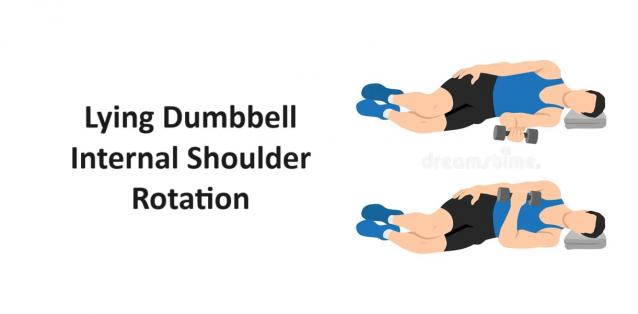The Lying Dumbbell Internal Shoulder Rotation is a beneficial exercise for targeting the internal rotator muscles of the shoulder. In this comprehensive guide, we’ll explore the correct technique, benefits, alternatives, and other essential details associated with the Lying Dumbbell Internal Shoulder Rotation.
Instructions
Setup:
- Lie Down: Lie on your side on a flat bench or on the floor. Ensure that your body is in a straight line from head to toe.
- Arm Position: Hold a dumbbell in the hand of the top arm. Bend your elbow to 90 degrees and keep it close to your body throughout the exercise. Your forearm should be perpendicular to the floor, with the dumbbell pointing upwards.
Execution:
- Internal Rotation: Exhale as you internally rotate your shoulder, bringing the dumbbell downwards towards the floor. Keep your elbow tucked in and maintain control over the movement.
- Range of Motion: Lower the dumbbell until you feel a comfortable stretch in your shoulder. Avoid going beyond a comfortable range of motion to prevent injury.
- Return to Starting Position: Inhale as you slowly return the dumbbell to the starting position, reversing the internal rotation movement. Keep the motion smooth and controlled.
- Repeat: Perform the desired number of repetitions on one side before switching to the other side.
Tips:
- Focus on isolating the internal rotator muscles of the shoulder throughout the movement.
- Keep your body stable and avoid excessive movement or rotation of the torso.
- Use a light to moderate weight dumbbell to ensure proper form and minimize the risk of injury.
Benefits
- Internal Rotator Strength: The Lying Dumbbell Internal Shoulder Rotation targets the internal rotator muscles of the shoulder, including the subscapularis, helping to strengthen and stabilize the rotator cuff.
- Improved Shoulder Mobility: Performing internal rotation exercises can help improve shoulder mobility and flexibility, which is important for maintaining proper joint function and reducing the risk of injury.
- Balance Muscle Development: Including internal rotation exercises in your workout routine helps to balance out the strength and function of the shoulder muscles, particularly if you perform a lot of exercises that involve external rotation.
- Injury Prevention: Strengthening the rotator cuff muscles can help prevent injuries such as rotator cuff strains, impingement, and instability, which are common in activities that involve repetitive overhead movements.
Muscles worked in Lying Dumbbell Internal Shoulder Rotation
The Lying Dumbbell Internal Shoulder Rotation primarily targets the internal rotator muscles of the shoulder, particularly the subscapularis. This muscle is one of the four muscles of the rotator cuff and is responsible for internally rotating the shoulder joint. Additionally, the exercise engages the following muscles to a lesser extent:
- Pectoralis Major: The sternal head of the pectoralis major assists in the internal rotation of the shoulder when performing the Lying Dumbbell Internal Shoulder Rotation.
- Anterior Deltoid: The front portion of the deltoid muscle is activated to a minor degree during the internal rotation movement.
- Teres Major: The teres major muscle, located near the armpit, also contributes to the internal rotation of the shoulder joint.
Overall, the exercise primarily targets the internal rotator muscles of the shoulder, particularly the subscapularis, which is essential for maintaining shoulder stability and proper joint function.
Alternate names for Lying Dumbbell Internal Shoulder Rotation:
- Prone Dumbbell Internal Rotation
- Supine Dumbbell Internal Rotation
- Lying Shoulder Internal Rotation
- Dumbbell Internal Rotation
Alternatives
- Resistance Band Internal Rotation: Use a resistance band anchored at waist height to perform internal rotation exercises, providing variable resistance throughout the movement.
- Cable Internal Rotation: Attach a D-handle to a cable machine at waist height and perform internal rotation exercises by pulling the handle towards your body.
- Prone Internal Rotation: Lie face down on a bench with your arm hanging down towards the floor and perform internal rotation exercises with a dumbbell or resistance band.
- Machine Internal Rotation: Use a shoulder internal rotation machine, typically found in gym settings, to perform internal rotation exercises with controlled resistance.
Conclusion
Incorporating the Lying Dumbbell Internal Shoulder Rotation into your workout routine can help strengthen the internal rotator muscles of the shoulder, improve shoulder mobility, and reduce the risk of injury. Focus on proper form, control the movement, and consider incorporating alternative exercises to keep your workouts varied and effective.
Also, check the Lying Dumbbell External Shoulder Rotation

